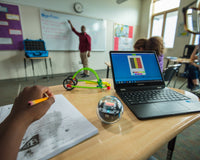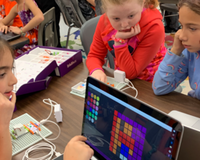When it comes to modern education, hybrid learning continues to grow in popularity — and for good reason. Providing the best of both traditional classrooms and virtual settings, hybrid learning allows students to receive flexible curriculum delivery that meets their individual learning styles and unique needs. Additionally, hybrid learning helps students learn 21st-century skills that will allow them to flourish in our increasingly technology-driven society.
Sphero resources and tools can help educators understand hybrid learning and its impact on students. This guide will uncover just what hybrid learning is, its unique advantages, and how to establish a successful hybrid learning environment yourself. Along the way, we will provide educational resources to help you get started on your hybrid learning journey.
What is Hybrid Learning?
At its core, hybrid learning is an educational model that combines in-person and online learning into one curriculum. This means that hybrid learning allows instructors to teach both in-person and remote students simultaneously. In doing so, instructors can ensure that each student is being taught based on their unique needs and that the subject matter is delivered in the best way possible.
Curious about hybrid learning and its applications in the classroom? Learn more about the concept of hybrid learning.
3 Advantages of Hybrid Learning
Many educators and school districts have turned to hybrid learning models due to their advantages over traditional methods. Here are 3 of the main benefits of hybrid learning:
1. Flexibility
With a hybrid learning model, students who are not attending class in person are given the flexibility to receive the same education from home. Additionally, educators can be more flexible with lesson plans and classroom structure. This allows educators to tailor their curriculums to suit different forms of subject matter delivery and learning styles seamlessly.
2. Student Empowerment
In a hybrid learning environment, students can explore and absorb information on their own, and share their unique findings with the class. And, for students who have a difficult time speaking up in front of peers, hybrid learning can empower them to discuss what they have learned via mediated or asynchronous online communication. Hybrid learning also presents a unique opportunity for students to learn self-discipline, as they have to address issues without the constant supervision of an in-person instructor.
3. Personalized Pacing
Pacing is one of the biggest advantages of establishing a hybrid learning curriculum. With online learning tools, students have the autonomy to access digital content (such as videos, recordings, readings, or discussion boards) as many times as they want and at their own speed.
This asynchronous learning style can be especially beneficial for students who struggle in fast-paced traditional classrooms. Learn more about autonomous and asynchronous learning styles in hybrid learning environments, as well as more unique benefits.
How To Establish a Hybrid Learning Environment
If you’re new to hybrid learning, it can feel overwhelming to build an in-person and digital curriculum. Fortunately, with the right plan, educational tools, and engaging activities, you can adapt to hybrid learning with ease. Here’s how to get started:
Plan Accordingly
Planning for your hybrid learning curriculum is your first step. To begin, focus on the design and layout of your classroom, as you’ll want it to work in favor of both in-person and remote students. Next, it’s important to decide what your students should learn independently and what activities require peer-to-peer collaboration.
Remember, online activities should provide asynchronous (self-paced) learning, while in-person class time is reserved for face-to-face interaction. Discover more on how to plan for your hybrid learning environment by asking yourself these 4 essential questions.
Use the Right Tools
Having the right tools for your hybrid classes is crucial to ensuring your students’ success. From online programs to in-person activities, it’s important to select tools that are user-friendly and engage students.
Want to go one step further with your hybrid learning tools? With hybrid and virtual learning STEM kits and tools, you can implement play-based learning into your virtual curriculum to help your students learn science, technology, engineering, and math (STEM).
Incorporate Engaging Lessons and Activities
A successful hybrid learning environment features lessons and activities that keep your students hooked and eager to learn. Whether you’re interested in teaching critical thinking skills or information literacy, try out some of these 19 STEM projects for virtual learning that ensure your students stay sharp.
Because remote students will have less face-to-face interaction with instructors and peers, fostering social-emotional skills is also important to incorporate in lessons. With the right social-emotional learning activities in your hybrid model, you can rest assured your students can manage emotions and adapt to environmental changes.
Evaluate
Evaluation is a critical final step to understanding how your students are handling the hybrid learning environment. While it might sound difficult to gauge your students’ progress or mood, handy monthly mood-tracking worksheets can help you uncover the quality of their learning experiences and social-emotional skills. With this information, you can better tailor your hybrid curriculum to meet the needs of students.
Discover the Benefits of Hybrid Learning
With hybrid learning, students can receive the best of both in-person and online learning opportunities. Not only does this allow educators to meet the unique learning needs of all students, but it also gives them the chance to work closely with the technology they will utilize well into adulthood.
At Sphero, we are proud to be educators’ resource for hybrid learning solutions. With our programmable robots, STEM kits, and educational guides, you can implement engaging, play-based learning activities into your in-person and virtual lesson plans with ease.
Explore first-hand accounts of how Sphero and littleBits have seen success with students in real schools around the world and discover what’s possible with your students today!










